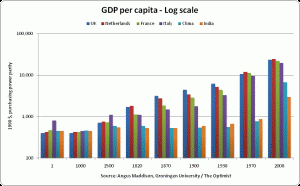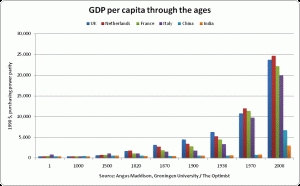A number of authors have argued that geography has been a decisive, or the decisive, factor explaining differences between human societies. Probably the most famous in mainstream circles is Jared Diamond, who argues in Guns, Germs and Steel that Eurasian societies came to dominate the world because they benefited from a greater number of, and more easily domesticable, crops and beasts of burdens. Now a new, and particularly interesting, example has caught my eye – this draft paper* argues that moderate levels of rainfall (550 to 1300 mm per year) are associated with stable democracy. (You can watch this interview on Bloomberg, with one of the authors of the paper, to get a quick overview of the research.) How does this work?
Well, say the authors, rainfall determines the economics of agricultural production. The economics of agricultural production determine social structures and the diffusion of wealth and power through pre-industrial society.  And when these are at levels that allow for “high levels and broad distributions of human capitalâ€, societies ultimately develop institutions (such as – and I’m putting words in the authors’ mouths here – a strong and well-educated middle class)  that are conducive to democracy.
How does rainfall affect the economics of agricultural production? Too low, the authors say, and societies end up with wealth being concentrated in the hands of the elite who control the water. Too high, and the crops available are hard to store or subject to extreme economies of scale, leading to large plantations worked by landless labourers. But just right and the family farm becomes economically viable, allowing ordinary farmers across the society in question to invest in their human capital.
Furthermore, this apparently holds true when controlled for a host of other variables:
We also show that this finding is robust to controlling for possible confounders, such as GDP per capita, income inequality, the percentage of the population that is Muslim, ethnic fractionalization, linguistic fractionalization, the percentage of the population that is Arab, the prevalence of malaria, colonial heritage, natural resource income (the “resource curseâ€), and regional fixed effects. In fact, we find that many of these well known correlates of democracy lose statistical significance once we condition on rainfall. Moreover, unlike many of these other correlates, rainfall is exogenous.
I’ve skimmed the paper itself and taken a more thorough look at this opinion piece by Amity Shlaes on Bloomberg, which was how I found out about the paper in the first place. I am not an expert in the areas that the paper covers, but it makes a lot of intuitive sense to me, and I think it’s well worth a look for anyone interested in the topic area.
* “Rainfall, Human Capital and Democracyâ€, by Stephen Haber of Stanford University and Victor Menaldo of the University of Washington.


